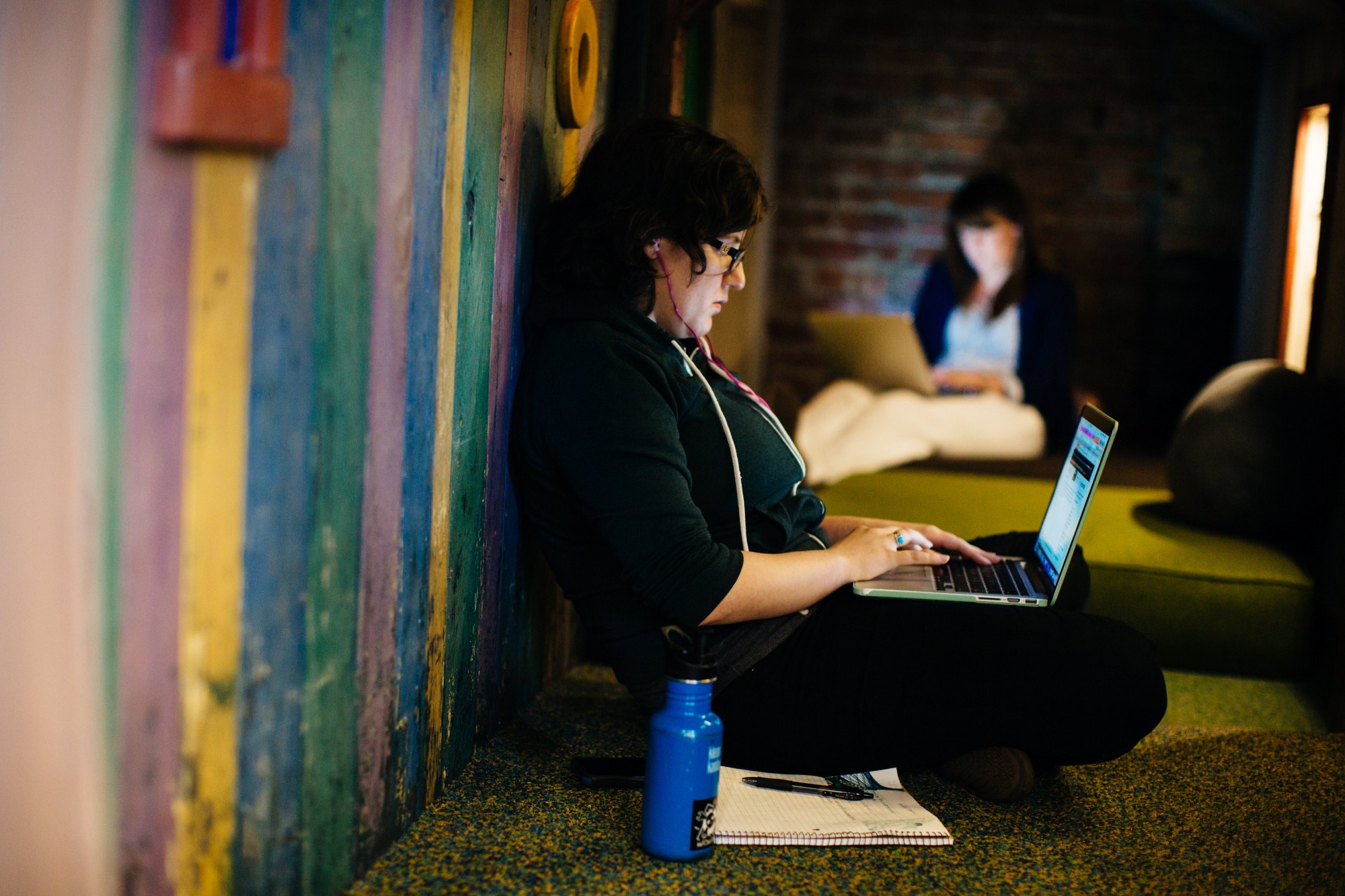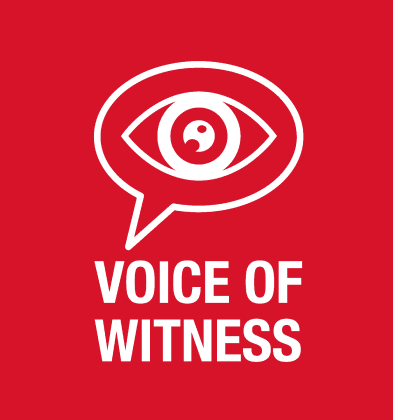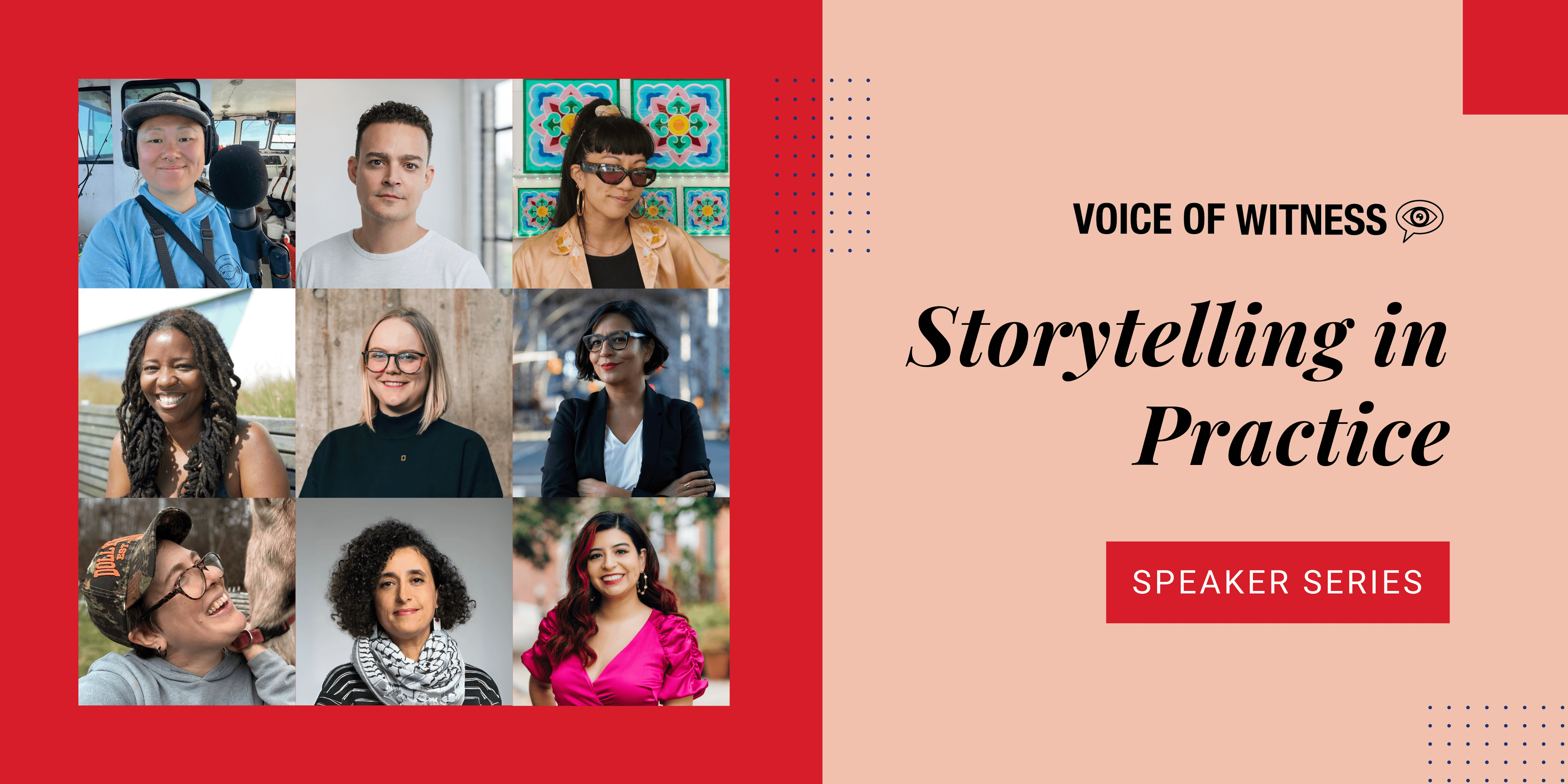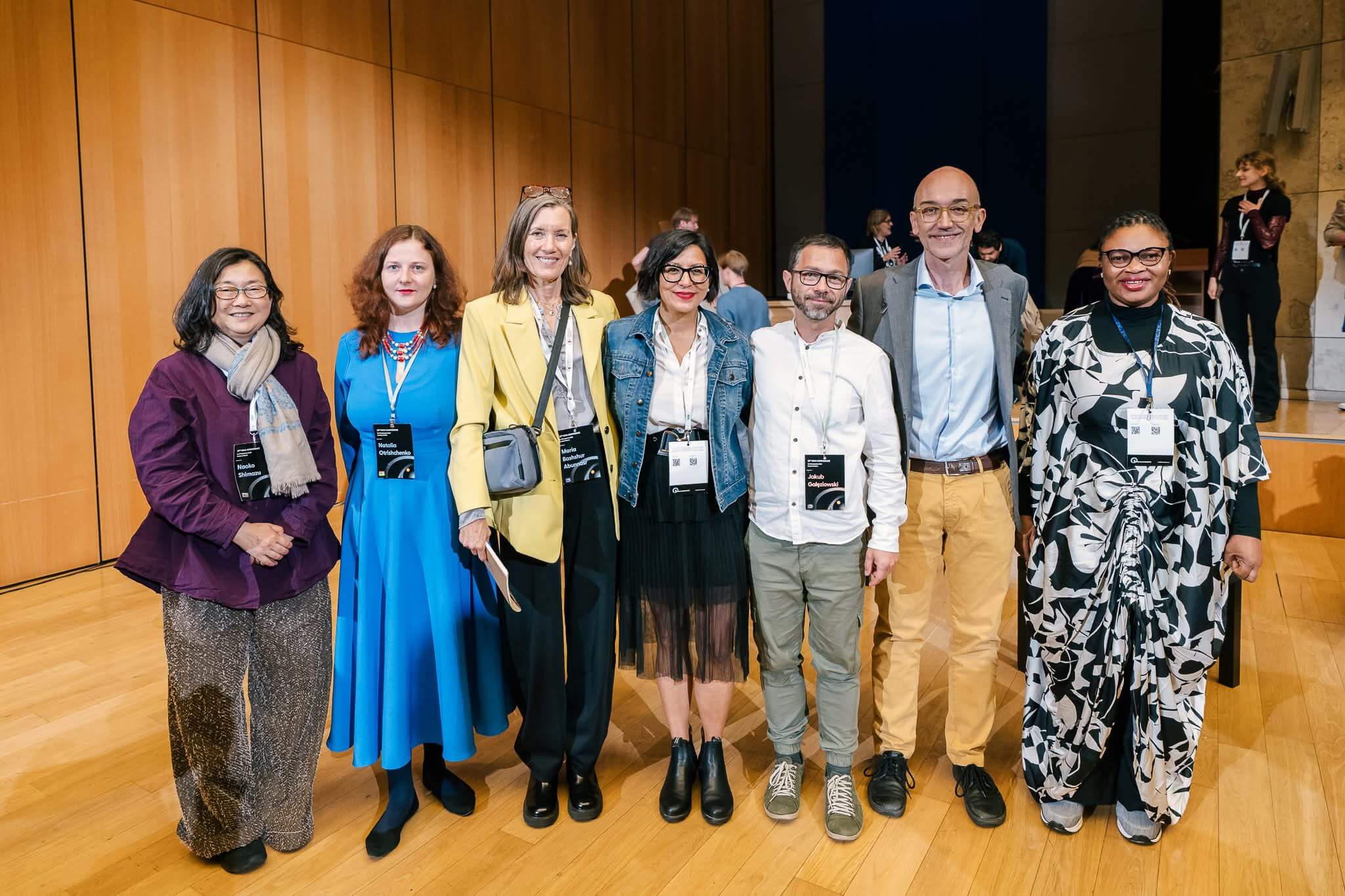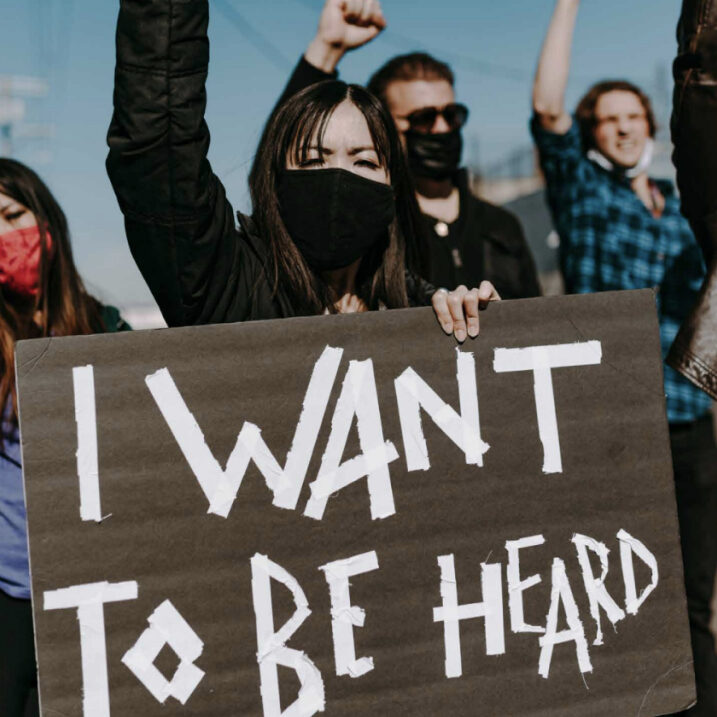Editor’s Note: The blog series “I, Witness,” seeks to explore the ethics, challenges, and possibilities of teaching and conducting oral history.
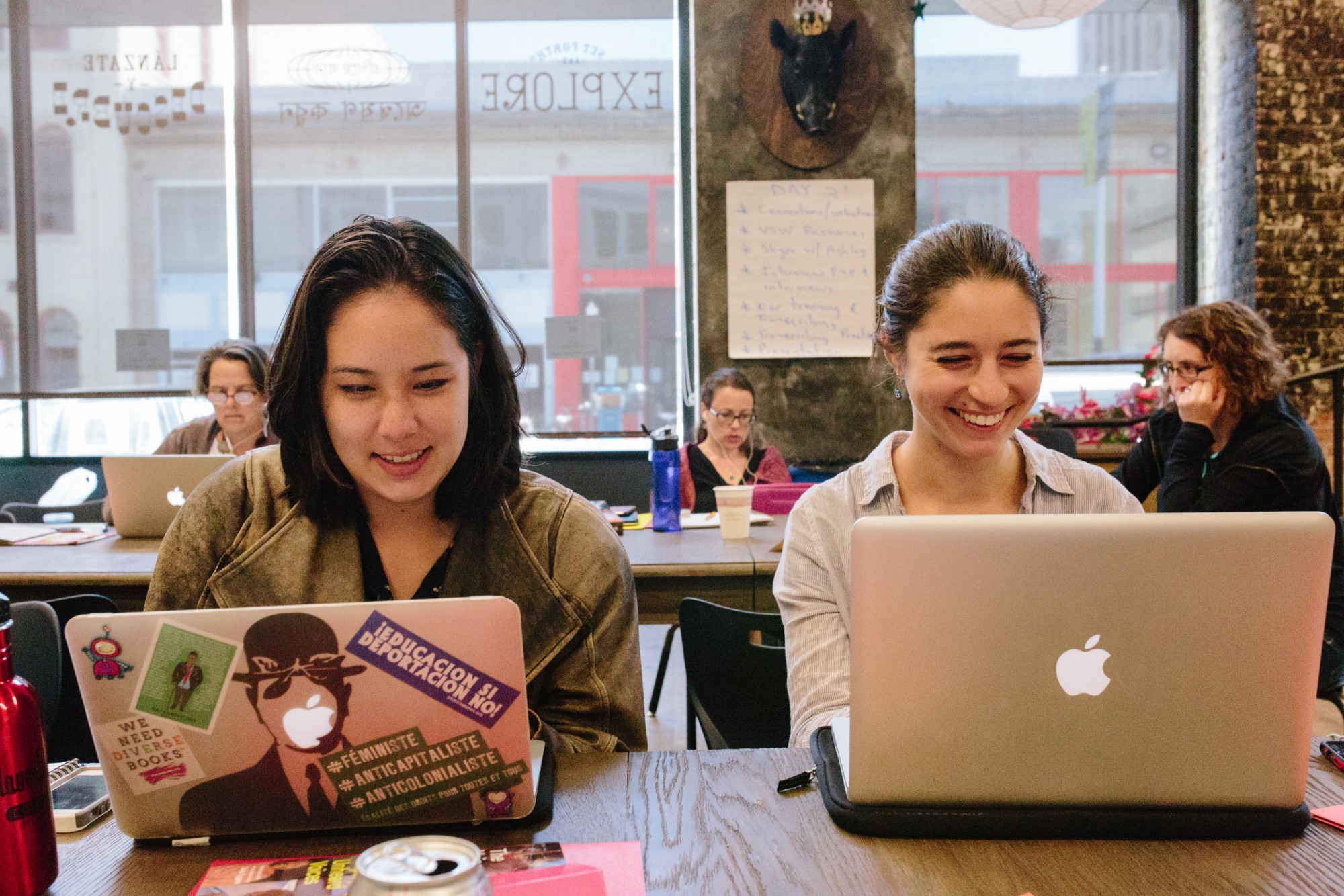
VOW summer 2016 interns Miriam Hwang-Carlos and Charlotte Edelstein. Photo courtesy of Lisa Anderson.
Miriam Hwang-Carlos and Charlotte Edelstein are Voice of Witness summer interns from Haverford College, outside Philadelphia. We asked them to reflect on our annual oral history training, which they attended as both participants and assistants, helping VOW Education staff Cliff Mayotte and Claire Kiefer. Held this year at the new 826 Valencia Tenderloin Center, Amplifying Unheard Voices (AUV) provides educators, storytellers, and social justice advocates with the tools and methodology to conduct oral history projects in their classrooms and communities.“Prepare, prepare, prepare, so that when we get in there, we can improvise.”
This is how VOW Education Program Director Cliff Mayotte described the work that goes into producing oral history—lots of preparation, knowing that you might have to throw it all to the wind. Because deeply listening to a person’s story requires you to be willing to change directions, willing to ask that unexpected follow-up question that will crack open the story the narrator needs to tell.
This is the work we had gathered to do during the 2016 Amplifying Unheard Voices (AUV) Oral History Workshop. We were twenty-three educators, graduate students, non-profit leaders, and aspiring storytellers with twenty-three different perspectives on how oral history can shape and transform our world.
Among us was a college professor who has her students interview members of an elderly care center, an artist who collaged in a visual journal throughout the week, and an advisor to low-income students who uses oral history to improve school policies. Many were Bay Area locals, but some had traveled from as far as Iowa, Kentucky, and Chicago to attend the training.PGJsb2NrcXVvdGUgY2xhc3M9InR3aXR0ZXItdHdlZXQiIGRhdGEtbGFuZz0iZW4iPjxwIGxhbmc9ImVuIiBkaXI9Imx0ciI+V2hvIGlzIHRoZSBsb29rZXI/IFdobyBpcyBiZWluZyBsb29rZWQgYXQ/IDxhIGhyZWY9Imh0dHBzOi8vdHdpdHRlci5jb20vaGFzaHRhZy9BVVYxNj9zcmM9aGFzaCI+I0FVVjE2PC9hPiA8YSBocmVmPSJodHRwczovL3R3aXR0ZXIuY29tL3ZvaWNlb2Z3aXRuZXNzIj5Adm9pY2VvZndpdG5lc3M8L2E+IDxhIGhyZWY9Imh0dHBzOi8vdC5jby8xcDJlUE1tWjM2Ij5waWMudHdpdHRlci5jb20vMXAyZVBNbVozNjwvYT48L3A+Jm1kYXNoOyBzdXNhbiB3b2xmIChAb2JqZWN0cGxhY2UpIDxhIGhyZWY9Imh0dHBzOi8vdHdpdHRlci5jb20vb2JqZWN0cGxhY2Uvc3RhdHVzLzc0NzU5MDYzODUyMzE1NDQzMiI+SnVuZSAyOCwgMjAxNjwvYT48L2Jsb2NrcXVvdGU+DQo8c2NyaXB0IGFzeW5jIHNyYz0iLy9wbGF0Zm9ybS50d2l0dGVyLmNvbS93aWRnZXRzLmpzIiBjaGFyc2V0PSJ1dGYtOCI+PC9zY3JpcHQ+We had dynamic guest speakers each day: from Charlie Stephens and her students, who shared with us their oral history project with elders, to Rick Ayers, who encouraged us to challenge our thinking around power and place in oral history interviewing.
We also heard from Pen Harshaw, who lit up the room while talking about OG Told Me, his five-years-in-the-making project interviewing elderly black men in Oakland, and from Lisa Thyer and Chris Wendelin, a teaching duo from outside Chicago who taught a Voice of Witness class at their school last year. We also got to Skype with Ashley Jacobs, a Voice of Witness narrator, who was open, funny, and vulnerable as she shared her experience being interviewed by Voice of Witness.PGJsb2NrcXVvdGUgY2xhc3M9InR3aXR0ZXItdHdlZXQiIGRhdGEtbGFuZz0iZW4iPjxwIGxhbmc9ImVuIiBkaXI9Imx0ciI+JnF1b3Q7V2hhdCYjMzk7cyB5b3VyIGNsYWltIHRvIGZhbWU/JnF1b3Q7IExlYXJuaW5nIGFib3V0IGdyZWF0IHF1ZXN0aW9uIHByb21wdHMgZm9yIHRhbGtpbmcgdG8geW91ciBjb21tdW5pdHkgZnJvbSA8YSBocmVmPSJodHRwczovL3R3aXR0ZXIuY29tL09HcGVubiI+QE9HcGVubjwvYT4gPGEgaHJlZj0iaHR0cHM6Ly90d2l0dGVyLmNvbS9oYXNodGFnL0FVVjE2P3NyYz1oYXNoIj4jQVVWMTY8L2E+IDxhIGhyZWY9Imh0dHBzOi8vdHdpdHRlci5jb20vaGFzaHRhZy9zdG9yaWVzZm9yY2hhbmdlP3NyYz1oYXNoIj4jc3Rvcmllc2ZvcmNoYW5nZTwvYT48L3A+Jm1kYXNoOyBLaXJzdGVuIEJ1bmNoIChAS2lyc3RlbkJ1bmNoKSA8YSBocmVmPSJodHRwczovL3R3aXR0ZXIuY29tL0tpcnN0ZW5CdW5jaC9zdGF0dXMvNzQ4NTY3Nzg0Nzk2MjM3ODI0Ij5KdW5lIDMwLCAyMDE2PC9hPjwvYmxvY2txdW90ZT4NCjxzY3JpcHQgYXN5bmMgc3JjPSIvL3BsYXRmb3JtLnR3aXR0ZXIuY29tL3dpZGdldHMuanMiIGNoYXJzZXQ9InV0Zi04Ij48L3NjcmlwdD4=PGJsb2NrcXVvdGUgY2xhc3M9InR3aXR0ZXItdHdlZXQiIGRhdGEtbGFuZz0iZW4iPjxwIGxhbmc9ImVuIiBkaXI9Imx0ciI+PGEgaHJlZj0iaHR0cHM6Ly90d2l0dGVyLmNvbS9PR3Blbm4iPkBPR3Blbm48L2E+IEkgYW0gaW5zcGlyZWQgYnkgeW91ciBjb21tLiBiYXNlZCBqb3VybmFsaXNtIGFuZCBwaG90b3MuIFRoYW5rIHlvdSBmb3Igc2hhcmluZyB3aXRoIDxhIGhyZWY9Imh0dHBzOi8vdHdpdHRlci5jb20vaGFzaHRhZy9BVVYxNj9zcmM9aGFzaCI+I0FVVjE2PC9hPiA8YSBocmVmPSJodHRwczovL3R3aXR0ZXIuY29tL3ZvaWNlb2Z3aXRuZXNzIj5Adm9pY2VvZndpdG5lc3M8L2E+IDxhIGhyZWY9Imh0dHBzOi8vdC5jby9KZlhBRlF0bVVTIj5waWMudHdpdHRlci5jb20vSmZYQUZRdG1VUzwvYT48L3A+Jm1kYXNoOyBEYW5lbGxlIFRheWxvciAoQGRhbmVsbGVwaG90bykgPGEgaHJlZj0iaHR0cHM6Ly90d2l0dGVyLmNvbS9kYW5lbGxlcGhvdG8vc3RhdHVzLzc0ODU2Njk4NzAzOTYxNzAyNCI+SnVuZSAzMCwgMjAxNjwvYT48L2Jsb2NrcXVvdGU+DQo8c2NyaXB0IGFzeW5jIHNyYz0iLy9wbGF0Zm9ybS50d2l0dGVyLmNvbS93aWRnZXRzLmpzIiBjaGFyc2V0PSJ1dGYtOCI+PC9zY3JpcHQ+Miriam on unheard family histories
I was excited to learn about the logistics of conducting an oral history, because working at Voice of Witness and reading the narratives in the book series has gotten me thinking about the unheard histories of my own family, and I’ve been mulling over the idea of interviewing my family members about their lives and compiling their stories somehow. I think about my grandparents’ lives, for example, and I realize there are a lot of gaps in my knowledge of their life stories.
One of Charlie Stephens’ students who visited our workshop interviewed his mom, and he commented on the value of sitting down and having a deliberate, in-depth conversation with someone he sees every day. He said he learned a lot about her life he hadn’t known before.
Charlotte asks the hard questions: What can a story actually do?
As someone who studies literature and human rights, I really want to believe in the power of narrative. Or, maybe more accurately, I want to believe in the personal power of telling your story.
But in the face of hearing about so many human rights violations and so much violence, in the face of hearing so many stories that trigger our empathetic response, it can become difficult to continue to believe that narrative is really that powerful.
On the second day of AUV, we spoke to former VOW narrator Ashley Jacobs via Skype. In her story, featured in Inside This Place, Not of It, Ashley describes the astonishing injustice she experienced while she was in prison: just under nine months pregnant, she was shackled to a delivery table before her due date and forced to have a C-section against her will.
Ashley told us that before her Voice of Witness interview, she had never spoken about her experiences in prison—not even to her family. But even though telling her story to a stranger was in some ways uncomfortable, it was also freeing.
This reflection was striking, as exploitation and re-traumatization are such huge concerns in oral history. But here was Ashley, explaining that recounting her story to a stranger was liberating, and that it ultimately empowered her to become an advocate for reproductive justice.
Of course, Ashley’s experience is not everyone’s experience (oral historians should certainly be thinking about the risks of re-traumatization and exploitation). But her story does allow us to reframe the question. Instead of asking whether a narrative really has the power to heal, to empower, or to inspire change, we can ask, Was Ashley’s experience narrating her story and being heard important and empowering for her? And Ashley can answer: yes. Ashley is now a certified medical assistant, and she’s even working on an oral history project interviewing women impacted by domestic violence.PGJsb2NrcXVvdGUgY2xhc3M9InR3aXR0ZXItdHdlZXQiIGRhdGEtbGFuZz0iZW4iPjxwIGxhbmc9ImVuIiBkaXI9Imx0ciI+JnF1b3Q7SW1wb3J0YW50IGZvciBhbnlvbmUgdG8gdHJvdWJsZSB0aGUgcmVsYXRpb25zaGlwIG9mIHdobyYjMzk7cyB0aGUgdGVsbGVyIGFuZCB3aG8mIzM5O3MgYmVlbiB0b2xkIGFib3V0LiZxdW90OyAtLTxhIGhyZWY9Imh0dHBzOi8vdHdpdHRlci5jb20vcmlja19heWVycyI+QHJpY2tfYXllcnM8L2E+IDxhIGhyZWY9Imh0dHBzOi8vdHdpdHRlci5jb20vaGFzaHRhZy9BVVYxNj9zcmM9aGFzaCI+I0FVVjE2PC9hPjwvcD4mbWRhc2g7IGthdGphLiAoQHN0cmViZXJrYXR6ZSkgPGEgaHJlZj0iaHR0cHM6Ly90d2l0dGVyLmNvbS9zdHJlYmVya2F0emUvc3RhdHVzLzc0ODI1Mjg3NDAzNTk5ODcyMCI+SnVuZSAyOSwgMjAxNjwvYT48L2Jsb2NrcXVvdGU+DQo8c2NyaXB0IGFzeW5jIHNyYz0iLy9wbGF0Zm9ybS50d2l0dGVyLmNvbS93aWRnZXRzLmpzIiBjaGFyc2V0PSJ1dGYtOCI+PC9zY3JpcHQ+Miriam’s oral history interview
With Ashley’s story fresh in our minds, we partnered up with other participants to interview each other. In pairs, we practiced both sides of the interview process—creating story-generating questions as interviewers, and telling our own stories as narrators.
I loved the experience of conducting and editing partner interviews with another participant. Though my partner and I didn’t share many demographic categories besides being both women, we connected quickly over the importance of identity in our lives.
As I interviewed her and she interviewed me, we saw our narratives mirror each other as we discussed navigating bicultural identities. When my partner spoke about her efforts to preserve her first language, Spanish, I was inspired in my attempts to learn my heritage language, Korean. When I spoke about being biracial, she thought of her future children and whether they might feel similarly or differently to me.
One of the best things I got out of the AUV training was this deep human connection, even though we only talked for about an hour.PGJsb2NrcXVvdGUgY2xhc3M9InR3aXR0ZXItdHdlZXQiIGRhdGEtbGFuZz0iZW4iPjxwIGxhbmc9ImVuIiBkaXI9Imx0ciI+V2hhdCBtYXNrcyBkbyB5b3Ugd2Vhcj8gV2hlbiB3ZXJlIHlvdSBpbnZpc2libGU/IDxhIGhyZWY9Imh0dHBzOi8vdHdpdHRlci5jb20vaGFzaHRhZy9BVVYxNj9zcmM9aGFzaCI+I0FVVjE2PC9hPiA8YSBocmVmPSJodHRwczovL3R3aXR0ZXIuY29tL3ZvaWNlb2Z3aXRuZXNzIj5Adm9pY2VvZndpdG5lc3M8L2E+IDxhIGhyZWY9Imh0dHBzOi8vdC5jby94VG1XVGRpUmFrIj5waWMudHdpdHRlci5jb20veFRtV1RkaVJhazwvYT48L3A+Jm1kYXNoOyBzdXNhbiB3b2xmIChAb2JqZWN0cGxhY2UpIDxhIGhyZWY9Imh0dHBzOi8vdHdpdHRlci5jb20vb2JqZWN0cGxhY2Uvc3RhdHVzLzc0NzU5MDI5MDc5ODYxMjQ4MiI+SnVuZSAyOCwgMjAxNjwvYT48L2Jsb2NrcXVvdGU+DQo8c2NyaXB0IGFzeW5jIHNyYz0iLy9wbGF0Zm9ybS50d2l0dGVyLmNvbS93aWRnZXRzLmpzIiBjaGFyc2V0PSJ1dGYtOCI+PC9zY3JpcHQ+Charlotte on what we mean when we talk about empathy
One of the concepts that I was introduced to during AUV that I found helpful in thinking through the power dynamics of oral history is the concept of teaching empathy. I’m cautious about expounding on the value and importance of generally having empathy, because I think empathy can often be confused with a certain dangerous kind of sentimentality.
James Baldwin describes this sentimentality as “the ostentatious parading of excessive and spurious emotion.” This type of sentimentality can lead to romanticizing, or projecting our own experiences onto a story, rather than truly listening to it. It values the listener’s perspective and emotion over the narrator’s. It is, in Baldwin’s words, “the signal of secret and violent inhumanity, the mask of cruelty.”
But in teaching empathy, we are teaching how to understand power dynamics, how to listen actively and ask questions that help the narrator explore the nuances of their own experiences.
Lisa and Chris’s presentation revealed that an oral history class is not just about teaching how to interview, transcribe, and edit, but that it’s also about creating a classroom environment in which empathy is valued.
Over the past year, Chris and Lisa worked with a class of 60 high school seniors to collect stories from the school community, including those of students and current and retired teachers.
They managed to do so much with their students—not only did the students hone their writing, interviewing, and editing skills, but together the class published a full length book documenting the stories and community members’ responses to them.
Chris said that one of the most rewarding aspects of the oral history process was seeing students who never would have interacted before finding unexpected points of connection.
This idea was a common thread throughout AUV. Teaching oral history and teaching empathy go hand in hand.PGJsb2NrcXVvdGUgY2xhc3M9InR3aXR0ZXItdHdlZXQiIGRhdGEtbGFuZz0iZW4iPjxwIGxhbmc9ImVuIiBkaXI9Imx0ciI+RWR1Y2F0b3IgPGEgaHJlZj0iaHR0cHM6Ly90d2l0dGVyLmNvbS9jaHJpc3dlbmRlbGluIj5AY2hyaXN3ZW5kZWxpbjwvYT4gb24gaG93IDxhIGhyZWY9Imh0dHBzOi8vdHdpdHRlci5jb20vaGFzaHRhZy9vcmFsaGlzdG9yeT9zcmM9aGFzaCI+I29yYWxoaXN0b3J5PC9hPiBjaGFuZ2VkIHRoZSBnYW1lIGZvciBoaXMgc3R1ZGVudHMuIDxhIGhyZWY9Imh0dHBzOi8vdHdpdHRlci5jb20vaGFzaHRhZy9BVVYxNj9zcmM9aGFzaCI+I0FVVjE2PC9hPiA8YSBocmVmPSJodHRwczovL3QuY28vOEFmOHVZdHZQSCI+cGljLnR3aXR0ZXIuY29tLzhBZjh1WXR2UEg8L2E+PC9wPiZtZGFzaDsgVm9pY2Ugb2YgV2l0bmVzcyAoQHZvaWNlb2Z3aXRuZXNzKSA8YSBocmVmPSJodHRwczovL3R3aXR0ZXIuY29tL3ZvaWNlb2Z3aXRuZXNzL3N0YXR1cy83NDgyMjMxNzIzMTEzMTg1MjgiPkp1bmUgMjksIDIwMTY8L2E+PC9ibG9ja3F1b3RlPg0KPHNjcmlwdCBhc3luYyBzcmM9Ii8vcGxhdGZvcm0udHdpdHRlci5jb20vd2lkZ2V0cy5qcyIgY2hhcnNldD0idXRmLTgiPjwvc2NyaXB0Pg==Miriam’s lingering questions
After the workshop I kept wondering how this reciprocal interviewing experience might differ from a more traditional oral history project where one person interviews and the other responds, and the two don’t trade places. With my partner and I, because we both took turns telling our stories, the interviews felt like a conversation. I’m curious to see how that would change in a situation where I was interviewing someone and not being interviewed by them in return. Would it feel less friendly and collegial? How would I do more to address the power dynamics between, as Rick Ayers put it, “the teller and the one being told about?”Story Circle and “Works in Progress”
To wrap up the week, we gathered in a circle to share excerpts from the narratives—or, as Cliff reminded us, “works in progress”—that we had created with our partners.
When it came time for everyone to select an excerpt, similar cries echoed throughout the room: “How can I choose just two minutes to share?”
“Can we have just ten more minutes to work on these?”
How could we capture the totality of a life in a two-minute narrative that we had gleaned from a thirty minute interview?
Yet, as we shared our stories, it became clear that we were not hearing anyone’s whole life story, nor were we supposed to. Instead, we heard tiny moments from each of our lives—a difficult first year of teaching, a relationship with a mother, a religious conversion, a semester abroad.
The richness of the stories as they filled the room mingled with the sense of absence we felt as we imagined the other layers of each other’s stories that we would never get to hear. This feeling really drove home the idea that oral histories are always works in progress. A narrator may tell their “life story,” but then they go on living, constantly modifying that “life story.” All of the concepts that we discussed this week—effective interviewing, honest empathy, negotiating power dynamics—are not static skills to be mastered once, but ongoing practices that we continually build up within ourselves and among our communities.
Get the latest updates on the VOW Education Program’s offerings. Join VOW’s mailing list.
